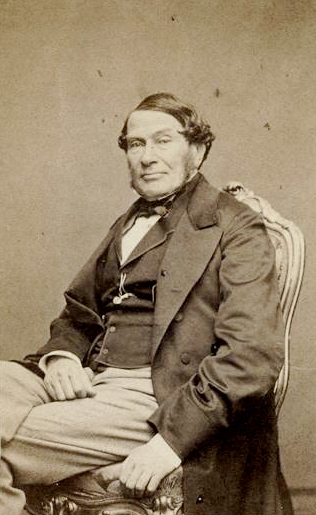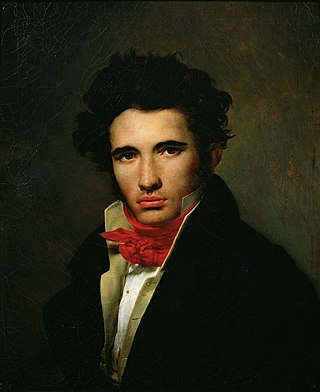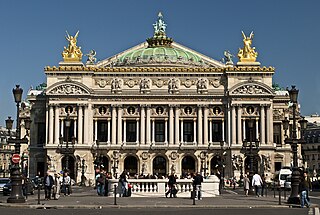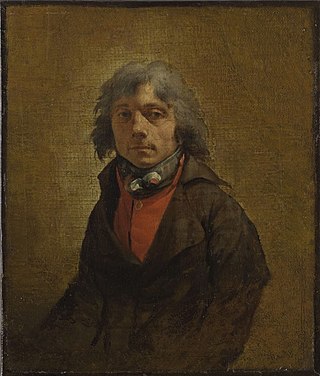
Ferdinand Victor Eugène Delacroix was a French Romantic artist who was regarded as the leader of the French Romantic school.

Charles Le Brun was a French painter, physiognomist, art theorist, and a director of several art schools of his time. He served as a court painter to Louis XIV, who declared him "the greatest French artist of all time". Le Brun was a dominant figure in 17th-century French art and was influenced by Nicolas Poussin.

Antoine Étex was a French sculptor, painter and architect.

Achille Marcus Fould was a French financier and politician who was four times minister of finance between 1849 and 1867. A major figure of the Second French Empire, his politics have been described as "conservative by instinct, liberal by reflection."

Léon Cogniet was a French history and portrait painter. He is probably best remembered as a teacher, with more than one hundred notable students.

François Pascal Simon Gérard, titled as Baron Gérard in 1809, was a French painter. He was born in Rome, where his father occupied a post in the house of the French ambassador, and his mother was Italian. After he was made a baron of the Empire in 1809 by Emperor Napoleon, he was known formally as Baron Gérard.

François-Édouard Picot was a French painter during the July Monarchy, painting mythological, religious and historical subjects.

Second Empire style, also known as the Napoleon III style, is a highly eclectic style of architecture and decorative arts originating in the Second French Empire. It was characterized by elements of many different historical styles, and also made innovative use of modern materials, such as iron frameworks and glass skylights. It flourished during the reign of Emperor Napoleon III (1852–1870) and had an important influence on architecture and decoration in the rest of Europe and North America. Major examples of the style include the Opéra Garnier (1862–1871) in Paris by Charles Garnier, the Institut National d'Histoire de l'Art, the Church of Saint Augustine (1860–1871), and the Philadelphia City Hall (1871–1901). The architectural style was closely connected with Haussmann's renovation of Paris carried out during the Second Empire; the new buildings, such as the Opéra, were intended as the focal points of the new boulevards.

Alexandre-Denis-Abel de Pujol or Abel de Pujol was a French painter. He was a student of David and his own students included Alexandre-Gabriel Decamps and Émile Lévy. He painted the ceiling of the grand-staircase at the Louvre as well as the galerie de Diane at Fontainebleau and the ceiling of the Bourse de Paris. A member of the Institut de France, he was an officer of the légion d'honneur.

Jean André was a French artist.

Martin Drolling aka. Drolling the Elder, was a French painter. He was father to Michel Martin Drolling, and to Louise-Adéone Drölling, one of the few successful female painters of the time.

Joseph Louis Hippolyte Bellangé was a French battle painter and printmaker. His art was influenced by the wars of the first Napoleon, and while a youth, he produced several military drawings in lithography. He afterwards pursued his systematic studies under Gros, and with the exception of some portraits, devoted himself exclusively to battle-pieces. In 1824, he received a second class medal for a historical picture, and in 1834 the decoration of the Legion of Honour, of which Order he was made an officer in 1861. He also gained a prize at the Paris Universal Exhibition of 1855.

Léon Auguste Adolphe Belly (1827–1877) was a French landscape painter.

Jacob Bunel was a French painter, associated with the Second School of Fontainebleau.

Adolphe-Félix Cals was a French portrait, genre, and landscape painter.

Charles Louis Müller was a French painter.

Claude-Marie-Paul Dubufe (1790–1864) a French historical, genre and portrait painter, was born in Paris in 1790, and studied under Jacques-Louis David. His subjects were at first classical, and then scriptural. He then gave himself up to the painting of genre pictures and portraits. His reputation rests chiefly on his portraits, of which he produced a large number. Dubufe, who was the last representative of the school of David, died at Selle-Saint-Cloud in 1864.

Félix-Joseph Barrias was a French painter. He was well known in his day for his paintings of religious, historical or mythical subjects, but has now been largely forgotten. Artists who trained in his studio and went on to achieve fame include Edgar Degas, Gustave Achille Guillaumet and Henri Pille.
Adolphe Schloss was a German-French art collector and an important broker of export goods, or commissionaire, with his firm Adolphe Schloss Fils et Co., particularly important in the trade of Parisian haute couture.

Portrait of Clemenceau is an oil painting on canvas of 1879–80 by Édouard Manet, now in the Musée d'Orsay. The work can be dated via two letters of 9 December 1879 and 8 January 1880 from their subject fixing sitting dates. Clemenceau was not happy with the work, stating "My portrait by Manet? Very bad, I don't have it and I don't mind that. It is at the Louvre, I ask myself why we put it there". But he enjoyed the sittings at Manet's home, enjoying the conversation and finding the painter very spiritual.




















